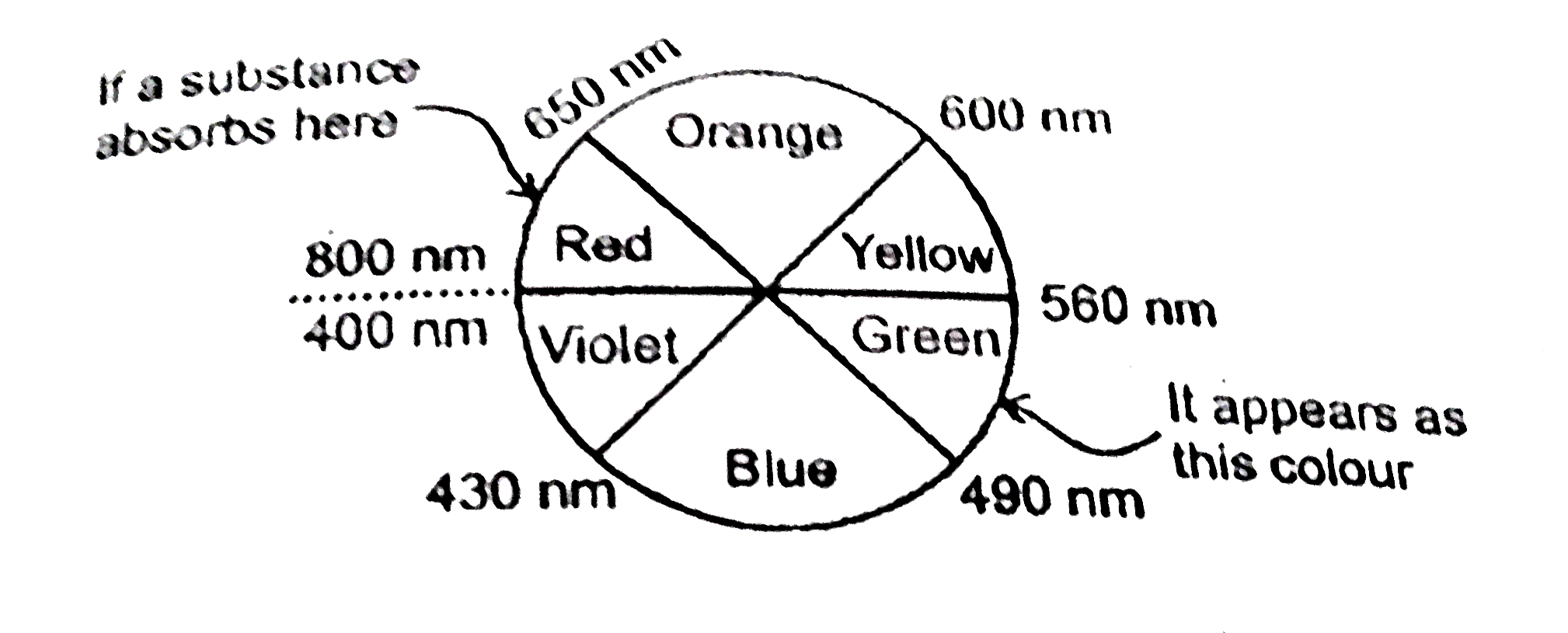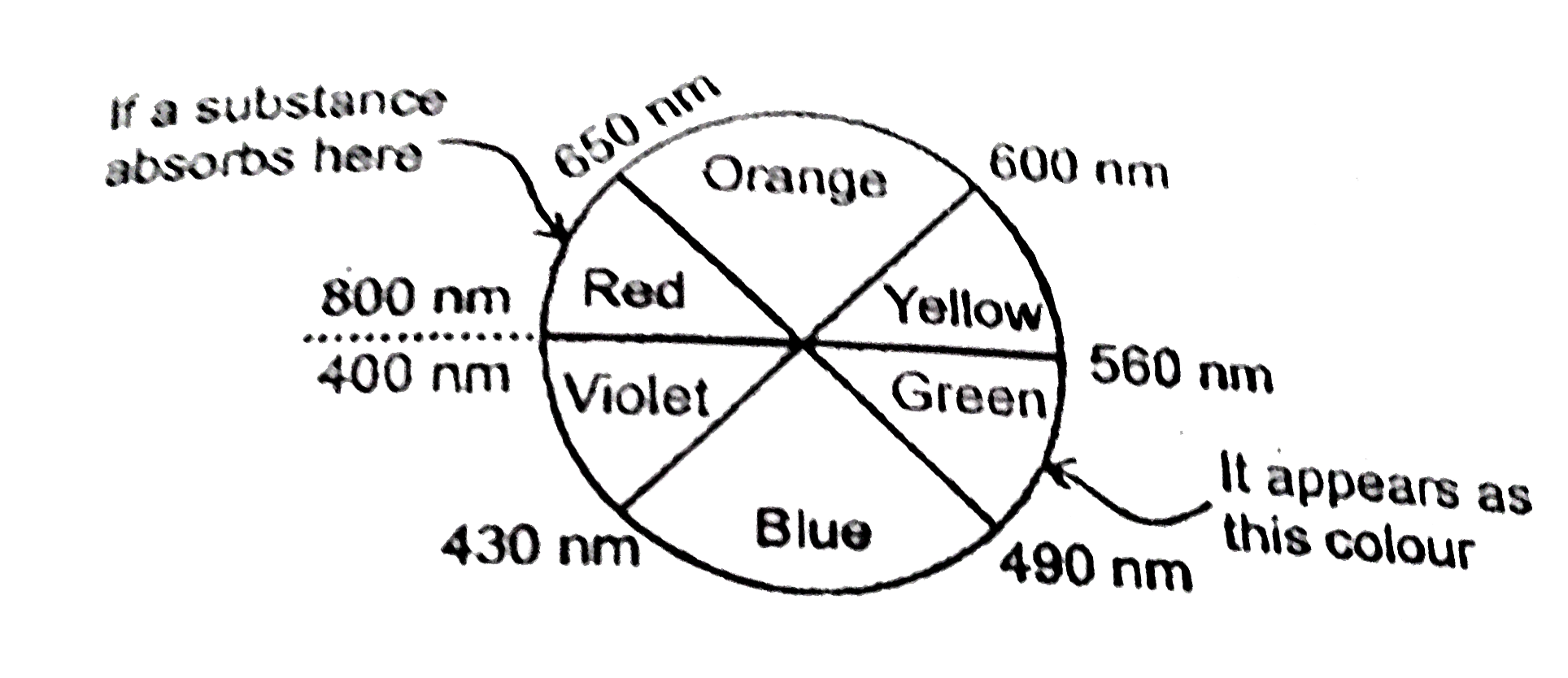Crystal field theory views the bonding in complexes as arising from electrostatic interaction and considers the effect of the ligand charges on the energies of the metal ion d-orbitals
In this theory, a ligand lone pair is modelled as a point negative charge that repels electrons in the d-orbitals of the central metal ion.The theory concentrated on the resulting splitting of the d-orbitals in two groups with different energies and used that splitting to rationalize and correlate the optical spectra,thermodynamic stability, and magnetic properties of complexes.This energy splitting between the two sets of d-orbitals is called the crystal field splitting Δ.
In general, the crystal field splitting energy Δ corresponds to wavelenght of light in visible region of the spectrum, and colours of the complexes can therefore be attributed to electronic transition between the lower and higher energy sets of d-orbitals.
In general, the colour that we see is complementry to the colour absorbed.

Different metal ions have different value of Δ, which explains why their complexes with the same ligand have different colour.
Similarly the crystal field splitting also depends on the nature of ligands and as the ligand for the same metal varies from H2O to NH3 to ethylenediamine, Δ for complexes increase.Accordingly, the electronic transition shifts to higher energy (shorter wavelength) as the ligand varies from H2O from NH3 to en, thus accounting for the variation in colour.
Crystal field theory accounts for the magnetic properties of complexes in terms of the relative values of Δ and the spin pairing energy P. Small Δ values favour high spin complexes, and large Δ values favour low spin complexes.
Which of the following statements is incorrect ?
The Ni2+ (aq) cation is coloured because Ni2+ ion can absorb light, which promotes electrons from the filled d-orbitals to the higher energy half filled d-orbitals
The Zn2+ (aq) cation is colourless because the d-orbitals are completely filled and no electrons can be promoted, so no light is absorbed
A complex which has just one absorption band at 455 nm, must be red coloured
None
The correct Answer is:C
As it absorbs blue colour light (λ=455 nm), the colour of the complex must be orange.
Topper's Solved these Questions
Similar Questions
A red solid is insoluble in water.However it becomes soluble if some KI is added to water.Heating the red solid in a test tube results in liberation of some violet coloured fumes and droplets of a metal appear on the cooler parts of the test tube.The red solid is :
View SolutionSodium (Na=23) crystallizes in bcc arrangement with the interfacial separation between the atoms at the edge 53.6±. The density of sodium crystal is :
View SolutionWhen the valence d-orbitals of the central metal ion split in energy in an octahedral ligand field, which orbitals are raised least in energy ?
View SolutionCrystal field theory views the bonding in complexes as arising from electrostatic interaction and considers the effect of the ligand charges on the energies of the metal ion d-orbitals In this theory, a ligand lone pair is modelled as a point negative charge that repels electrons in the d-orbitals of the central metal ion.The theory concentrated on the resulting splitting of the d-orbitals in two groups with different energies and used that splitting to rationalize and correlate the optical spectra,thermodynamic stability, and magnetic properties of complexes.This energy splitting between the two sets of d-orbitals is called the crystal field splitting Delta . In general, the crystal field splitting energy Delta corresponds to wavelenght of light in visible region of the spectrum, and colours of the complexes can therefore be attributed to electronic transition between the lower and higher energy sets of d-orbitals. In general, the colour that we see is complementry to the colour absorbed. Different metal ions have different value of Delta , which explains why their complexes with the same ligand have different colour. Similarly the crystal field splitting also depends on the nature of ligands and as the ligand for the same metal varies from H_2O to NH_3 to ethylenediamine, Delta for complexes increase.Accordingly, the electronic transition shifts to higher energy (shorter wavelength) as the ligand varies from H_2O from NH_3 to en, thus accounting for the variation in colour. Crystal field theory accounts for the magnetic properties of complexes in terms of the relative values of Delta and the spin pairing energy P. Small Delta values favour high spin complexes, and large Delta values favour low spin complexes. The [Ti(NCS)_6]^(3-) ion exhibits a single absorption band at 544 nm.What will be the crystal field splitting energy (in kJ mol^(-1) ) of the complex ? (h=6.626xx10^(-34) J.s, C=3.0xx10^5 m//s, N_A=6.02xx10^23 ions/mole.
View SolutionCrystal field theory views the bonding in complexes as arising from electrostatic interaction and considers the effect of the ligand charges on the energies of the metal ion d-orbitals
In this theory, a ligand lone pair is modelled as a point negative charge that repels electrons in the d-orbitals of the central metal ion.The theory concentrated on the resulting splitting of the d-orbitals in two groups with different energies and used that splitting to rationalize and correlate the optical spectra,thermodynamic stability, and magnetic properties of complexes.This energy splitting between the two sets of d-orbitals is called the crystal field splitting Δ.
In general, the crystal field splitting energy Δ corresponds to wavelenght of light in visible region of the spectrum, and colours of the complexes can therefore be attributed to electronic transition between the lower and higher energy sets of d-orbitals.
In general, the colour that we see is complementry to the colour absorbed.

Different metal ions have different value of Δ, which explains why their complexes with the same ligand have different colour.
Similarly the crystal field splitting also depends on the nature of ligands and as the ligand for the same metal varies from H2O to NH3 to ethylenediamine, Δ for complexes increase.Accordingly, the electronic transition shifts to higher energy (shorter wavelength) as the ligand varies from H2O from NH3 to en, thus accounting for the variation in colour.
Crystal field theory accounts for the magnetic properties of complexes in terms of the relative values of Δ and the spin pairing energy P. Small Δ values favour high spin complexes, and large Δ values favour low spin complexes.
Which of the following complexes are diamagnetic ?
[Pt(NH3)4]2+[Co(SCN)4]2−[Cu(en)2]2+[HgI4]2−square planartetrahedralsquare planartetrahedral(i)(ii)(iii)iv
View SolutionCrystal field theory assumes that interaction between the metal ion and ligand is ________.
View SolutionThe crystal field theory assumes interaction between metal ion and the ligands as a purely electrostatic and ligands are supposed to be point charges.
Q. Which of the following match are incorrect?

View SolutionThe crystal field theory assumes interaction between metal ion and the ligands as a purely electrostatic and ligands are supposed to be point charges.
Q. Amongst the following complexes which has square planar geometry?
View SolutionAccording to cystal field theory, interaction between central metal atom/ion and ligand is electrostatic in nature. In free metal ions, the five d-orbitals are degenerate. However, in a ligand field e.g., tetrahedral, octahedral, square planar, square pyramidal, trigonal bipyramidal, the degeneracy of 5d-orbitals is lost.
If lobes of d-orbitals of central metal atom/ion are along the axes through which ligands are approaching, the energy of corresponding d-orbital is raised more than the d-orbitals having lobes between teh axes. e.g., octahedral complexes, square planar complexes, square pyramidal compexes.
Which of the following orbitals has the highest energy in square pyramidal ligand field ?
View SolutionCrystal field theory considers purely ionic bond between metal and ligand. The five d-orbitals in an isolated gaseous metal are degenerate. The degeneracy of the d-orbitals is lost in prsence of ligand which is known as splitting of d-orbitals. Complex in which t(2g)^(3) electronic configuration is not observed.
View SolutionAccording to cystal field theory, interaction between central metal atom/ion and ligand is electrostatic in nature. In free metal ions, the five d-orbitals are degenerate. However, in a ligand field e.g., tetrahedral, octahedral, square planar, square pyramidal, trigonal bipyramidal, the degeneracy of 5d-orbitals is lost. If lobes of d-orbitals of central metal atom/ion are along the axes through which ligands are approaching, the energy of corresponding d-orbital is raised more than the d-orbitals having lobes between teh axes. e.g., octahedral complexes, square planar complexes, square pyramidal compexes. Which of the following orbitals has the highest energy in square pyramidal ligand field ?
View SolutionCrystal field theory considers purely ionic bond between metal and ligand. The five d-orbitals in an isolated gaseous metal are degenerate. The degeneracy of the d-orbitals is lost in prsence of ligand which is known as splitting of d-orbitals. Complex in which t(2g)^(3) electronic configuration is not observed.
View SolutionAccording to crystal field theory ,The bond between the ligand and central metal atom is __________
View SolutionThe crystal field theory assumes interaction between metal ion and the ligands as a purely electrostatic and ligands are supposed to be point charges. Q. Which of the following match are incorrect?
View SolutionThe crystal field theory assumes interaction between metal ion and the ligands as a purely electrostatic and ligands are supposed to be point charges.
Q. Amongst the following complexes which has square planar geometry?
View Solution
